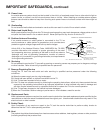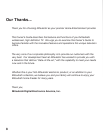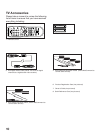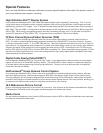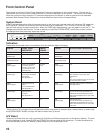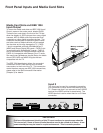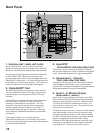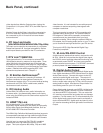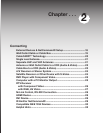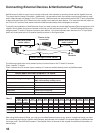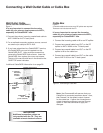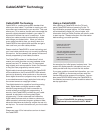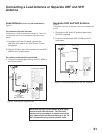
14
15
Back Panel, continued
video signals from Monitor Outputs when viewing the
Component 1 & 2 inputs, INPUT-DTV, the HDMI input or
Cards 1-4.
Monitor Output Audio/Video 1 should be connected to
a VCR for recording. Monitor Output Audio 2 should
be connected to your A/V receiver for home theater
surround sound.
6. PC Input and Audio
(VGA/WVGA/SVGA/WSVGA/XGA/720p, 60Hz)
This input can be used for the connection of a computer.
Please see Appendix B for signal compatibility. Stereo
audio inputs are also provided for the PC connection.
7. DTV Link™/IEEE1394
These jacks allow the TV to connect to external IEEE
1394 digital products by means of a single cable. Three
jacks (one on the front panel and two on the back) are
provided for this purpose, which allow for a high degree
of flexibility for connecting your NetCommand controlled
system. Detailed information regarding IEEE 1394
connection requirements are in Chapter 4.
8. IR Emitter-NetCommand
®
Two jacks are provided for connecting IR emitters. IR
Emitters connected to these jacks are used by the
NetCommand system of the TV to control external analog
devices such as VCRs, DVDs, cable boxes, satellite
receivers and audio receivers.
9. DVI Analog Audio
Unlike HDMI, DVI does not carry audio information on
the same cable. Use these analog stereo audio inputs
when using the HDMI input with a device that outputs DVI
instead of HDMI.
10. HDMI™/M-Link
M-Link(MonitorLink™) is a Mitsubishi exclusive
proprietary digital interface for the display of high quality
digital video signals from Mitsubishi products, such as
the HD-6000 HDTV Receiver/Controller.
The HDMI (High Definition Multimedia Interface) supports
uncompressed standard and high definition digital video
formats and existing digital multi-channel audio formats.
Use this input to connect to EIA/CEA-861 compliant
devices such as a high definition receiver or DVD
player. This input supports 480i, 480p, 720p and 1080i
video formats. It is not intended for use with personal
computers or devices outputting video signals with
computer resolutions.
This input can also be used as a DVI connection with
separate analog audio inputs. An optional HDMI-to-
DVI adaptor or cable will be necessary to make this
connection and may be available from your local
electronics retailer. When using the optional HDMI-to-
DVI adapter, the DVI analog audio inputs on your TV allow
you to receive left and right audio from your DVI device.
This input is HDCP (High-Bandwidth Digital Copy
Protection) compliant.
11. M-Link/RS-232C Control
A digital control interface that works in conjunction with
M-Link. While M-Link provides the digital video signal,
the RS-232 control provides enhanced functioning such
as automatic power ON/OFF and input port selection
with an external control system. For RS-232C command
protocol please visit www.mitsubishi-tv.com.
12. Digital Audio Output
This output will automatically send Dolby® Digital audio
from digital channels and IEEE 1394 devices to a digital
Audio/Video receiver. Connect this output to the A/V
receiver’s coaxial digital audio input. The output will
automatically turn off when viewing an analog channel or
device, except when using the TV Disc, which converts
analog audio to digital. Use Monitor Output Audio 2 to
send analog sound to your A/V receiver.
Some digital cable channels send MPEG-1 digital audio
instead of Dolby Digital, however, not all A/V receivers
can decode MPEG-1 digital audio. This can cause the
A/V receivers to produce a loud noise that can damage
speakers. For this reason, the TV will automatically turn
off the digital audio output when tuned to a channel or
device that has MPEG-1 digital audio and send it to the
A/V receiver as analog left and right audio from Monitor
Output.



